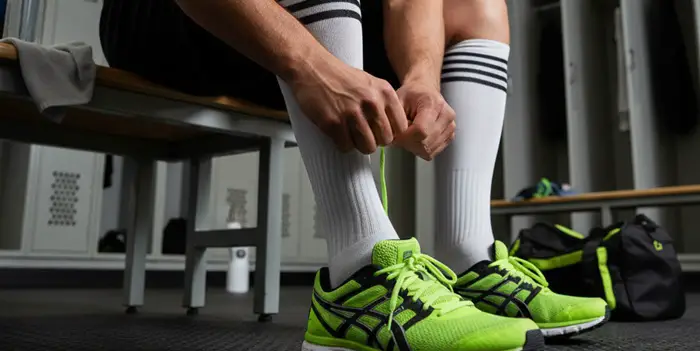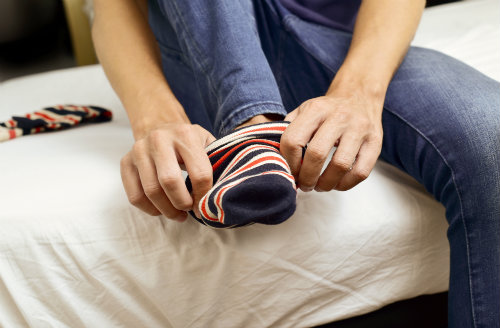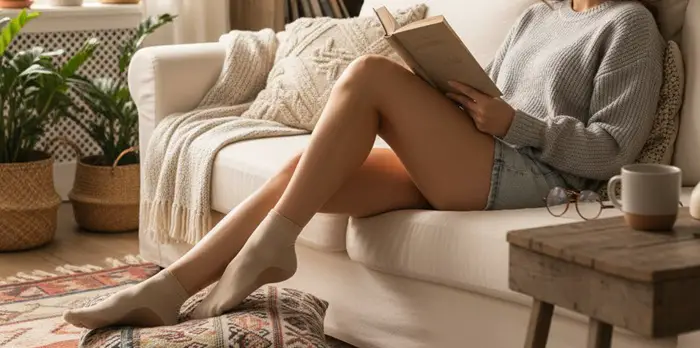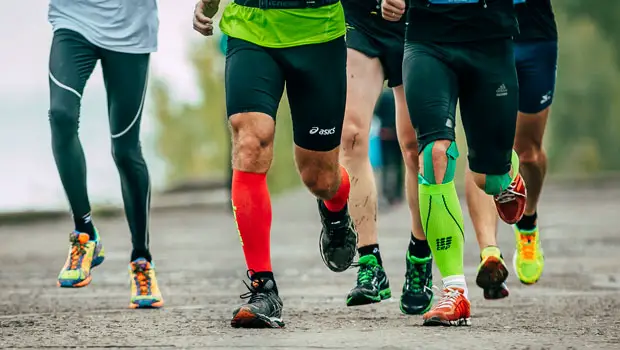
Athletes are always searching for small performance edges—those tiny tweaks that can make training more efficient, recovery faster, and endurance stronger.
While most focus on nutrition, hydration, or training load, one often overlooked weapon is compression socks.
Yes, those snug, knee-high garments aren’t just for grandmas on long flights—they’re a secret weapon for runners, cyclists, basketball players, and even gym rats who want to go the extra mile without feeling like their legs are made of concrete.
But here’s the kicker: not all compression socks are created equal. Some are built for medical recovery, others for athletic performance, and some look great but do very little.
So, before you pull on the first pair you see on Amazon, let’s break down everything you need to know—types, functions, and the best compression socks for athletes that actually deliver results.
Types of Compression Socks
Whether you are a casual runner or a pro athlete, remember that not all compression socks are designed the same way.
Their pressure levels, construction style, and intended purpose determine how they’ll feel and perform.
1. Pressure Levels
Compression socks are categorized by the amount of pressure (measured in mmHg—millimeters of mercury) they apply to your legs:
- Mild (8–15 mmHg): Gentle support, best for everyday use or travel.
- Moderate (15–20 mmHg): Ideal for light athletic use, swelling prevention, or long standing hours.
- Firm (20–30 mmHg): The most popular range for athletes—enhances circulation and supports muscle recovery.
- Extra Firm (30–40 mmHg): Generally for medical use or severe venous issues.
For sports performance and post-training recovery, 20–30 mmHg is usually the sweet spot.
2. Compression Types
There are two main kinds:
- Graduated Compression: Tighter at the ankle and gradually looser toward the calf or thigh. This promotes blood flow upward and reduces swelling.
- Uniform Compression: Even pressure throughout the leg—useful for specific medical needs but less effective for sports performance.
3. Styles
Depending on your activity and comfort, you can choose from:
- Knee-high socks: Great for runners and cyclists.
- Over-the-calf socks: Preferred by athletes who need maximum lower-leg support.
- Compression Sleeves: Cover just the calf area, perfect if you prefer your regular socks but still want muscle compression.
Material also matters. Most athletic compression socks use a blend of nylon, spandex, and elastane, ensuring breathability, durability, and a snug yet flexible fit. Look for moisture-wicking fabrics that keep your legs dry and odor-free.
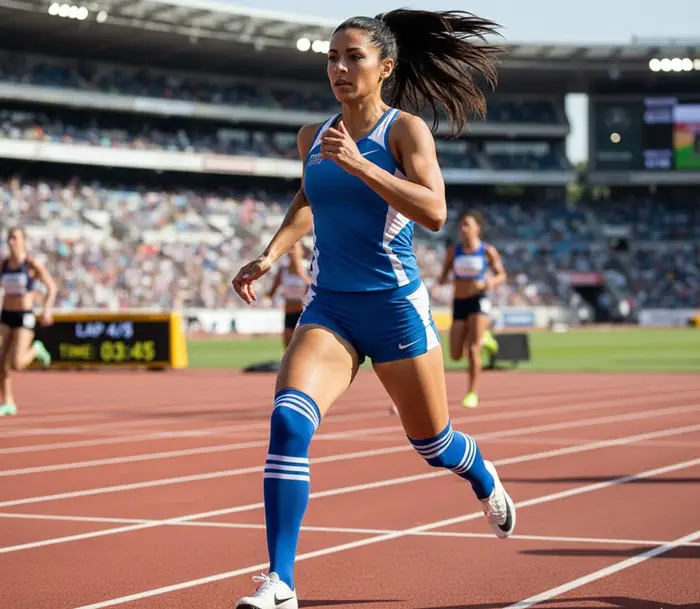
What Exactly Do These Socks Do?
In simple terms, compression socks help your blood fight gravity. When you train or compete, blood and fluids can pool in your lower legs, leading to swelling or leg cramps, fatigue, and even soreness.
Here’s how compression socks work their magic:
- Boost circulation: Graduated pressure helps blood return to the heart faster, preventing stagnation.
- Reduce muscle vibration: During intense runs or cycling sessions, they stabilize your calves, reducing micro-tears and soreness.
- Enhance oxygen delivery: Better blood flow = more oxygen and nutrients for your muscles.
- Prevent ankle injuries and foot pain: Consistent compression gives added joint stability.
- Speed up recovery: Post-workout, compression reduces lactic acid buildup and inflammation.
They’re especially handy if you’re prone to shin splints or if your calves feel tight after every leg day. Some athletes even wear them while sleeping to improve recovery overnight (though comfort levels vary).
The 7 Best Compression Socks for Athletes
There are hundreds of compression socks on the market for hikers, joggers, athletes, and workout fanatics—but only a few truly combine performance, comfort, and science-backed compression.
Here are seven that consistently top athlete recommendations:
1- Doc Miller Compression Socks

Doc Miller compression socks (20-30 mmHg) are made up of premium quality, durable material that is highly breathable and comfortable.
These calf compression sleeves not only boost blood circulation in your legs to prevent injuries but also aid in faster recovery of strained muscles to provide you with improved performance and support while walking, running, or sporting.
These sleeves are also available in the open-toe and closed-toe versions that can be used as pregnancy maternity stockings.
Sold as a pair, some of the interactive features that come with these Doc Miller medical-grade compression sleeves are:
- Good for men, women, and teens
- Perfect opaqueness for professional look and feel
- Comfortable material to feel fresher and active for long
- Available in toeless, open toe, closed-toe, and calf sleeve versions
- 90-day money-back satisfaction guarantee with world-class customer service
2- Physix Gear Sport Socks

Physix Gear Compression Socks are equally designed for men & women and it comes with a 20-30 mmHg compression rating.
Not only do these highly durable compression socks help in boosting style and confidence but also your stamina, circulation, and recovery time.
These socks come with moisture-wicking properties that can rapidly air dry in just a few hours. This means you do not need to worry about getting them sticky due to sweat in extremely hot weather.
Ideal for extreme races long runs, half marathons, or CrossFit through mud water wall/crawl/rope climbs; these socks do not have any awkward stitches at places where they’ll rub or rip together.
Few additional features that make these socks simply the best are:
- Available in a variety of colors
- Highly breathable, easy to put on and off
- Comfortable material that can be washed easily
- Double-stitched Lycra fabric for high durability and comfort
3- Bluemaple Compression Socks

One of the best in our list of compression socks, Bluemaple offers you the unmatched premium quality for relieving all your swelling and varicose veins.
Ideal for athletic sports, running, Crossfit, flight travel, and much more these socks for men and women are available with 15-43 mmHg compression level in a below knee-high design.
Whether you are a nursing mother or a striving father who works long hours in a physically exhausting job, these Bluemaple socks can provide you the best comfort to your tired legs.
These are made with easy wicking and quick-drying fibers to provide better air permeability by maintaining the proper temperature.
Be it summer or winter season, you can wear these all-season socks to keep your legs comfortable.
Few additional highlighted features of these compression stockings for swelling are:
- Highly breathable and moisture-absorbent
- Available in varied colors and designs to suit your style
- Made up of 85% nylon, 10% polyester, 5% elastane
- Complete satisfaction with 100% money-back guarantee
4- Jobst Thigh High Stockings

JOBST Relief Thigh High Compression Stockings comes with 15-20 mmHg compression grading and is reinforced heel designed to offer long-lasting durability.
This unisex stocking includes Silicone Dot Band that helps to keep this compression garment in place all day long. And it’s Open Toe style provides much room to your toe for maximum comfort.
The material used in this compression sleeve is woven with a 3-D knit structure using air-covered spandex yarn that offers a soft touch and comfortable feel to the socks for all-day wearing.
Furthermore, this JOBST Relief compression stocking is available in light beige color that can match well with all your garments.
Few other highlighted features included are:
- Appropriate for both men and women
- Extra wiggle room for toe and thigh-high design
- Latex-free and contains 80% nylon and 20% spandex
5- HLTPRO Compression Stockings

HLTPRO Compression Socks are made up of 80% nylon/20% spandex and are equally beneficial for women & men.
Available in 20-30 mmHg grading these knee-high compression stockings are best for running, foot/ankle swelling, varicose veins, shin splints, and others.
While athletes can use them for running these are also helpful while travelers, nurses, teachers, office workers, and just anyone who needs to stand a long time on their feet.
Few best features that come with these stockings are:
- Soft and easy to put on and off
- Excellent quality at a reasonable price
- Available in a wide range of assorted colors
- Made up of moisture-wicking, poly-nylon fabric
6- SocksLane Cotton Socks

SocksLane cotton compression socks are designed especially for women who are hunting for stylish yet best supportive stockings for long-term comfort to their legs and feet.
These knee-high compression stocking comes with a 15-20 mmHg medical circulation hose and is ideal for nurses, maternity, travel, flight, pregnancy, varicose veins, calf support, etc.
Few other highlights of these best cotton compression socks are:
- Made up of 65% combed cotton and high-quality anti-allergy fibers
- Naturally breathable, anti-bacterial, anti-odor, and anti-allergic material
- Fit perfectly all day long without any chafing – neither too tight nor too long
7- Laite Hebe Compression Socks

Laite Hebe compression socks for women & men are highly fashionable and trendy which means you need not invest in a fashion garment for your feet when you buy these medical-grade compression stockings.
By integrating the art of fashion, technology, and science Laite Hebe has designed for you triple comfort without making you overpay.
These socks provide the much-needed compression & support on the heel, foot, calves, and toe area without squeezing your aching toe joints.
Not only do these best compression socks for athletes help in relieving leg swelling issues but also prevent blood clots after surgery.
Other highlighting features of these compression socks are:
- Delivers 360-degree stretch for greater flexibility and durability
- Made of highly comfortable, breathable, and moisture-absorbent material
- Satisfaction guarantee with a full refund or free replacement if not satisfied
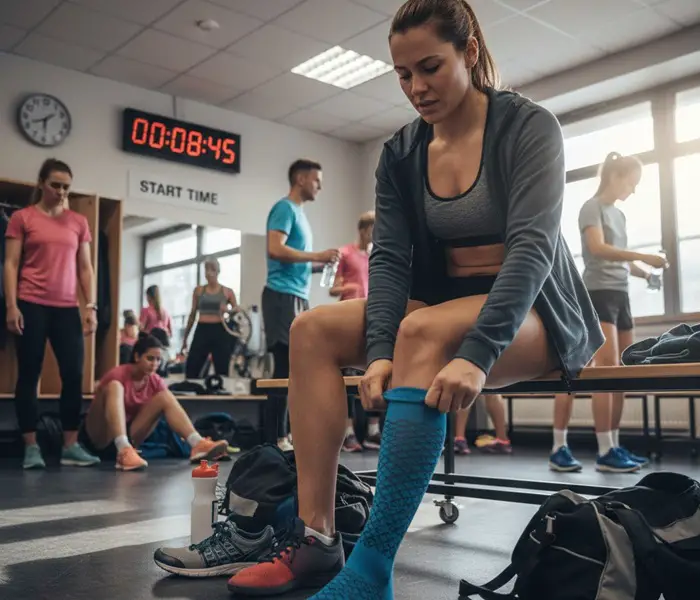
When Should an Athlete Wear Compression Socks?
For athletes, compression socks aren’t just for race day. Their benefits shine before, during, and after activity:
- Before training: Wear them 30–45 minutes before workouts to warm up your muscles and improve blood flow.
- During workouts: Ideal for endurance sports like running, cycling, or HIIT sessions. They minimize fatigue and protect from micro-trauma.
- After workouts: Continue wearing them for a few hours post-training to accelerate recovery and reduce swelling.
- While sleeping: Optional—but some athletes find nighttime use helps reduce next-day stiffness.
For best results, avoid wearing the same pair for over 24 hours straight without washing or air-drying them.
What to Look at When Choosing Compression Socks for Athletes?
Picking the right pair goes beyond flashy colors and logos. Here are some of the qualities you should look for in compression socks when buying:
✅ Length
When buying recovery socks, you want them too big enough to end below your knee and cover your shin and calf completely.
The seam may irritate your knee back if it is very high and won’t render the right compression if they are excessively short.
✅ Breathability
If the socks aren’t breathable, you cannot wear them.
Producers try to use different materials to enhance sock breathability especially for your toes, feet, and heel which get the hottest when exercising inside the shoe.
A compression sock with breathable material teamed with moisture-wicking enhances the price.
✅ Moisture-wicking
A compression sock may get itchy if it doesn’t permit moisture to go and can start smelling.
Wicking works by allowing the fabric to pull the moisture in and permit it to evaporate faster via capillary action.
When you have a material that wicks away moisture, the socks can be used for running, workouts, etc.
When purchasing a compression sock, check for socks made from a blend of elastine and polyester and synthetic fabrics.
✅ Smooth Seams
A garment with smooth seams doesn’t irritate your skin. When you wear a compression sock, you should go for the socks which have the lowest seams or have smooth and flat stitching.
Just like other athletic wear, your sock seams shouldn’t be noticeable at all.
✅ Medical Grade
If you wish to shop for a compression sock, then make sure you search for “medical grade”.
Several brands claim to have the perfect compression levels, but may not mark “medical grade” which brings you to the risk of not getting the perfect quality or tightness for you to get relief.
✅ Compression levels
With the SI unit mmHg, the same as blood pressure, the compression socks are tested for compression which they create after being made.
There is a range of different compression levels that can be found when buying socks which range between 15 to 30mmHg.
While it is important to keep all these above-mentioned points in mind you could be buying a good running compression sock based on your personal preference as well so that you get maximum benefits out of it.
Besides, Athletes Who Need Compression Socks and Sleeves the Most (and Why)?
While these socks were designed for athletes, their benefits extend to many people in different walks of life.
Essentially, anyone dealing with poor circulation, long hours of sitting or standing, or frequent leg fatigue can gain from them.
Here are some groups who benefit the most:
- People with Deep Vein Thrombosis (DVT): Compression improves venous return and reduces clot risk.
- Individuals with obesity: Helps manage fluid retention and prevents swelling.
- Pregnant women: Reduces pressure on the legs and prevents varicose veins.
- Women on birth control pills: Hormonal changes can affect circulation—compression offers protection.
- Heavy smokers: Helps counteract reduced blood vessel elasticity.
- Office workers or long-distance truck drivers: Long sitting hours can slow circulation—compression boosts it back up.
- Frequent flyers (especially long-haul): Prevents swelling and leg discomfort from sitting still for hours.
- People with varicose veins: Reduces discomfort and visible vein bulging.
- Nurses and healthcare workers: On their feet for 10–12 hours, compression reduces fatigue.
- Seniors: Supports aging veins and promotes better leg comfort.
Even recreational gym-goers or weekend runners find compression socks a game-changer for managing swelling or leg cramps and preventing ankle injuries and foot pain.
Who Should Not Wear Compression Socks?
Despite their numerous benefits, compression socks aren’t suitable for everyone. Certain medical conditions can worsen with external pressure, so consultation with a doctor is a must if you fall into one of these categories:
- Peripheral Artery Disease (PAD): The restricted arterial blood flow may further decrease under compression.
- Latex allergy: Some socks contain latex in their elastic bands, triggering allergic reactions.
- Uncontrolled or advanced diabetes: Can cause nerve damage, leading to reduced leg sensation—compression could worsen circulation in such cases.
Also, if you experience pain, numbness, or tingling while wearing them, remove the socks immediately and consult a healthcare professional.
Related FAQs
Can I wear compression socks all day?
Yes, but it depends on your purpose. Many athletes wear them during training and for a few hours post-workout. For everyday use or travel, it’s fine to wear them for up to 12 hours—as long as they feel comfortable and your legs don’t feel restricted.
Are compression sleeves as effective as full socks?
Compression sleeves target only the calf muscles, offering excellent support and circulation benefits. However, they don’t support the foot or ankle, so for full-leg benefits or ankle injuries and foot pain prevention, socks are superior.
Should I wear compression socks while sleeping?
It’s safe for most people, especially for recovery, but comfort is subjective. If they feel too tight or restrict movement, remove them. Those with diabetes or PAD should avoid nighttime use unless advised by a doctor.
Can compression socks help with shin splints?
Yes, they can. Compression stabilizes the calf muscles, reducing vibration and pressure on the tibia—helpful for both preventing and managing shin splints.
How do I wash and maintain my compression socks?
Always hand-wash or use a gentle machine cycle with mild detergent. Avoid fabric softeners and high heat. Air-dry flat to maintain elasticity and material integrity.
Final Thoughts
Compression socks are no longer just a niche medical accessory—they’re a science-backed athletic performance tool. Whether you’re pounding pavement, cycling up hills, or recovering from leg day, they can help keep your muscles oxygenated, supported, and ready for the next challenge.
The key lies in choosing the right material, compression level, and size to suit your activity and comfort. For most athletes, 20–30 mmHg knee-high socks strike the perfect balance between performance and recovery.
Remember: when used correctly, compression socks can make your legs feel fresher, reduce swelling or leg cramps, and even prevent ankle injuries and foot pain. But when used without awareness (especially with conditions like diabetes or PAD), they can do more harm than good.
So, invest wisely, measure accurately, and give your legs the support they deserve—because even the strongest athlete performs best on a solid foundation.
People searched for:- Physix Gear Compression Socks Men & Women (20-30 mmHg) Best Graduated Athletic Fit Running Nurses Shin Splints Flight Travel

